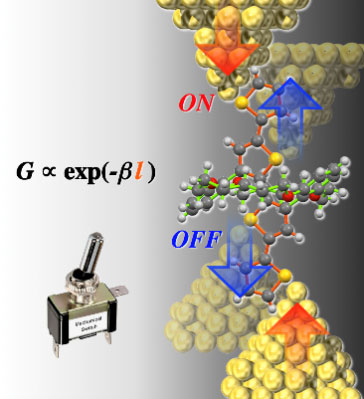| Posted: Nov 13, 2014 |
Switching on the future: Electronic switches on the molecular scale
|
|
(Nanowerk News) A molecular electronic switch is a junction created from individual molecules that can alternate between two or more stable states, making the switch act as a conductor or an insulator. These switches show promise for future applications in molecular electronics where individual molecules or molecular complexes act as electronic components. However, developing a working, reversible and repeatable molecular electronic switch on the molecular scale remains a challenging task.
|
|
Now, Shintaro Fujii, Manabu Kiguchi, Kazunori Sugiyasu (NIMS), Hisao Nakamura (AIST) and colleagues, have shown that a molecular electronic switch with multi-conductance states (for example, high, medium and low states) is possible using a single quarter thiophene-based junction ("Single Molecular Resistive Switch Obtained via Sliding Multiple Anchoring Points and Varying Effective Wire Length"). In this new switch, the switching behavior is triggered by external mechanical force.
|
 |
| A new molecular electronic switch with three conductance states has been developed by researchers at Tokyo Tech. On-off switching is controlled by an external mechanical force.
|
|
The team prepared the single quarter thiophene junctions, bridged between two gold electrodes, using scanning tunneling microscopy (STM) - more specifically, the STM-based mechanically controllable break junction (STM-BJ) method. They then applied an external mechanical force to the junction via a piezo actuator.
|
|
The quarter thiophene-based molecule consists of four thiophene rings and has four binding sites that attach to the gold electrodes. Owing to the structural symmetry, Fujii, Kiguchi and co-workers found three types of binding configuration for the junction. Their STM-BJ experiment and theoretical simulation revealed that the quarter thiophene junction exhibits three conductance states with distinct electronic conductivities. These three states depend on the binding sites of the molecules, and the external mechanical force induces reversible switching among the three conductance states.
|
|
Molecular junctions with multi anchor-sites such as these, coupled with the dynamic control of different possible binding sites, could lead to the development of functional molecular devices with resistive switching types.
|

